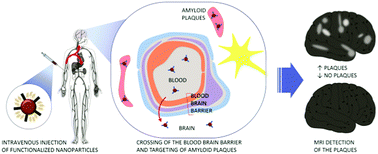当前位置:
X-MOL 学术
›
J. Mater. Chem. B
›
论文详情
Our official English website, www.x-mol.net, welcomes your
feedback! (Note: you will need to create a separate account there.)
Nanoparticles as contrast agents for brain nuclear magnetic resonance imaging in Alzheimer's disease diagnosis
Journal of Materials Chemistry B ( IF 6.1 ) Pub Date : 2017-07-28 00:00:00 , DOI: 10.1039/c7tb01599b David Azria 1, 2, 3, 4, 5 , Sébastien Blanquer 1, 2, 3, 4, 5 , Jean-Michel Verdier 5, 6, 7, 8, 9 , Emmanuel Belamie 1, 2, 3, 4, 5
Journal of Materials Chemistry B ( IF 6.1 ) Pub Date : 2017-07-28 00:00:00 , DOI: 10.1039/c7tb01599b David Azria 1, 2, 3, 4, 5 , Sébastien Blanquer 1, 2, 3, 4, 5 , Jean-Michel Verdier 5, 6, 7, 8, 9 , Emmanuel Belamie 1, 2, 3, 4, 5
Affiliation

|
Nuclear Magnetic Resonance Imaging (MRI) of amyloid plaques is a powerful non-invasive approach for the early and accurate diagnosis of Alzheimer's disease (AD) along with clinical observations of behavioral changes and cognitive impairment. The present article aims at giving a critical and comprehensive review of recent advances in the development of nanoparticle-based contrast agents for brain MRI. Nanoparticles considered for the MRI of AD must comply with a highly stringent set of requirements including low toxicity and the ability to cross the blood–brain-barrier. In addition, to reach an optimal signal-to-noise ratio, they must exhibit a specific ability to target amyloid plaques, which can be achieved by grafting antibodies, peptides or small molecules. Finally, we propose to consider new directions for the future of MRI in the context of Alzheimer's disease, in particular by enhancing the performances of contrast agents and by including therapeutic functionalities following a theranostic strategy.
中文翻译:

纳米粒子作为对比剂,用于阿尔茨海默氏病诊断中的脑核磁共振成像
淀粉样蛋白斑的核磁共振成像(MRI)是一种强大的非侵入性方法,可用于早期和准确诊断阿尔茨海默氏病(AD)以及行为变化和认知障碍的临床观察。本文旨在对用于脑部MRI的基于纳米粒子的造影剂的最新进展进行批判性和全面的综述。考虑用于AD MRI的纳米颗粒必须符合一系列严格的要求,包括低毒性和穿越血脑屏障的能力。另外,为了达到最佳信噪比,它们必须表现出靶向淀粉样蛋白斑的特定能力,这可以通过嫁接抗体,肽或小分子来实现。最后,
更新日期:2017-09-13
中文翻译:

纳米粒子作为对比剂,用于阿尔茨海默氏病诊断中的脑核磁共振成像
淀粉样蛋白斑的核磁共振成像(MRI)是一种强大的非侵入性方法,可用于早期和准确诊断阿尔茨海默氏病(AD)以及行为变化和认知障碍的临床观察。本文旨在对用于脑部MRI的基于纳米粒子的造影剂的最新进展进行批判性和全面的综述。考虑用于AD MRI的纳米颗粒必须符合一系列严格的要求,包括低毒性和穿越血脑屏障的能力。另外,为了达到最佳信噪比,它们必须表现出靶向淀粉样蛋白斑的特定能力,这可以通过嫁接抗体,肽或小分子来实现。最后,











































 京公网安备 11010802027423号
京公网安备 11010802027423号